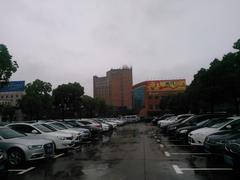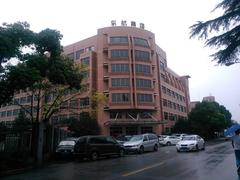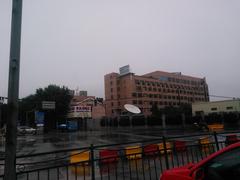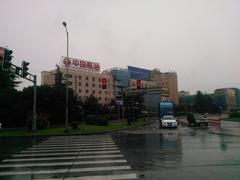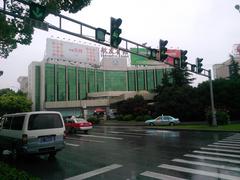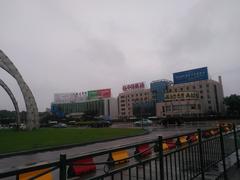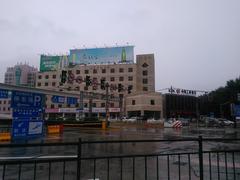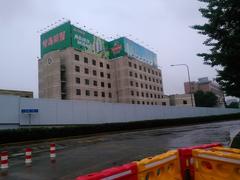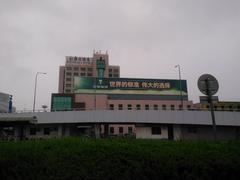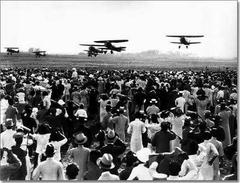
Shanghai Hongqiao International Airport
Shanghai Hongqiao International Airport (SHA) Visiting Guide: Tickets, Hours, and Travel Tips
Date: 14/06/2025
Introduction
Shanghai Hongqiao International Airport (SHA) is a cornerstone of China’s aviation and transportation landscape, blending over a century of history with state-of-the-art infrastructure. Located just 13 kilometers from downtown Shanghai, SHA is a multi-modal transportation hub integrating domestic and select international flights, high-speed rail, and urban transit. This guide delivers comprehensive, up-to-date information for visitors—including operating hours, ticketing, terminal amenities, transportation options, and nearby attractions—ensuring a smooth and enjoyable journey through one of China’s busiest airports (Simple Flying; World Travel Guide; Wikipedia).
Table of Contents
- History and Development
- Practical Visitor Information
- Transportation and Connectivity
- Nearby Attractions
- Shopping, Dining, and Terminal Comfort
- Cleanliness and Sustainability
- Frequently Asked Questions (FAQ)
- Summary Table: Key Facilities and Services
- Conclusion
- Sources
History and Development
Early Origins and Pre-War Period (1907–1949)
Shanghai Hongqiao International Airport began as a military airfield in 1907, strategically positioned between Shanghai and Qingpu counties (Simple Flying). By 1921, construction of the airfield was completed, but regular civilian flights were delayed due to financial constraints. It transitioned to civilian use in 1923, operating with a basic dirt runway (Sixth Tone). Through the Republican era, the airport saw intermittent use due to political and economic instability.
Post-1949 Rebuilding and Expansion
After 1949, Hongqiao was primarily used for military purposes. In 1963, the airport was expanded to support both military and civilian flights, eventually replacing Longhua Airport as Shanghai’s main gateway (Changning Government). The airport officially reopened for civilian use in 1964 and became fully public in 1971 (China Airline Travel).
Reform, Opening-Up, and Modernization (1980s–1990s)
The 1980s and 1990s saw rapid modernization, with major terminal expansions in 1984, 1991, and 1996 to accommodate soaring passenger numbers (Simple Flying). By 1995, Hongqiao was handling flights to 86 destinations, serving over a million passenger car movements annually, and managing substantial cargo volumes (Changning Government). The airport also spurred the development of the Hongqiao Economic and Technological Development Zone.
Transition to a Domestic Hub (1999–2009)
With the opening of Shanghai Pudong International Airport in 1999, most international flights shifted there, and Hongqiao focused on domestic and regional routes (Wikipedia). Despite this, it continued to handle some international flights to Hong Kong, Macau, and Taiwan. By 2009, the airport was handling over 25 million passengers per year (Airport Technology).
Modern Expansion and the Hongqiao Transportation Hub (2010–Present)
In preparation for Expo 2010, Hongqiao underwent a RMB 15.3 billion expansion, including the construction of Terminal 2 (four times the size of T1) and a second runway (Wikipedia; Airport Technology). Integration with the adjacent Hongqiao Railway Station formed one of the world’s largest transportation hubs, connecting air travel with major high-speed rail lines and metro services (World Travel Guide). By 2023, SHA served over 42 million passengers (Wikipedia), earning a Skytrax 5-Star Airport Rating for its facilities and service (Wikipedia).
Practical Visitor Information
Visiting Hours
SHA operates 24/7, with passenger service and check-in desks typically available from early morning to late night. Check-in counters open 2–3 hours before flight departure and close 40 minutes prior (China Airline Travel). Confirm with your airline for precise check-in times.
Ticketing and Check-In
Purchase tickets online, via travel agencies, or at airport counters in Terminals 1 and 2. For domestic flights, arrive at least two hours early to allow time for check-in and security, especially during holidays. International travelers should arrive three hours in advance.
Facilities and Services
- Free Wi-Fi: Register for complimentary internet access throughout the terminal.
- Dining: A wide range of Chinese, Western, and Japanese cuisine is available.
- Shopping: Duty-free, luxury brands, and convenience stores are found in both terminals.
- Luggage Storage: Short-term lockers are located on the first floor of each terminal.
- Hotel: The Shanghai Boyue Hotel in Terminal 2 is ideal for transit stays.
- Information Counters: Multilingual staff and clear signage assist with navigation (Tour Beijing).
Accessibility and Special Assistance
SHA offers extensive accessibility features: ramps, elevators, tactile paving, accessible restrooms, and the Red Hat Warm Service Group, which provides personalized support for the elderly, pregnant, and disabled travelers (Shanghai Highlights).
Visa-Free Transit and Mobile Payments
- Visa-Free Transit: Citizens from 54 countries can enjoy 240-hour visa-free stays when transiting to a third country (China Airline Travel).
- Mobile Payments: AliPay and WeChat Pay are widely accepted for everything from dining to transportation (World Travel Guide).
Special Events and Observation Decks
Exhibitions and cultural events are occasionally held in public areas. Observation decks in Terminal 2 provide excellent runway views, especially during early morning and late afternoon.
Transportation and Connectivity
Intermodal Hub and High-Speed Rail Integration
SHA anchors the Hongqiao Comprehensive Transportation Hub, integrating:
- Shanghai Hongqiao Railway Station: Asia’s largest, offering high-speed trains to Beijing, Hangzhou, Nanjing, and more (Wikipedia).
- Metro Lines 2, 10, and 17: Direct access to central Shanghai and suburbs.
- Bus and Taxi: On-site taxi stands and city bus routes (GoShopShanghai).
Metro, Taxi, and Bus Options
- Metro: Lines 2 and 10 connect SHA with downtown in about 20 minutes (CNY 3–5). Line 17 serves western suburbs (Trip.com).
- Taxi: Available at arrivals; fares to city center range from CNY 65–97. Carry your destination in Chinese.
- Buses: Several routes serve the airport, with bilingual announcements.
New Airport Link Line
Launched in late 2024, the Airport Link Line connects SHA and Pudong International Airport in 40 minutes, compared to 90 minutes by metro (ChinaDaily; Shanghai.gov.cn). The 68.6 km route features modern C-type trains with amenities like luggage racks and charging ports, and fares start at RMB 26 (China Airline Travel).
Nearby Attractions
- Zhujiajiao Water Town: Historic canal town 30 minutes by car.
- Longhua Temple: One of Shanghai’s oldest Buddhist temples, 20 minutes away.
- Hongqiao Business District: Modern shopping and entertainment near the airport.
- Shanghai Museum, Yuyuan Garden, Jing’an Temple: Easily reached by metro.
Shopping, Dining, and Terminal Comfort
- Terminals: T1 (International & partial domestic), T2 (Domestic).
- Shops: Duty-free, luxury, and essentials.
- Dining: International and local eateries.
- VIP Lounges: 18 premium lounges for business/first-class and eligible frequent flyers (Skytrax).
- Rest Zones: Quiet and family-friendly seating areas.
- Cleanliness: High standards with frequent sanitation and green initiatives.
Cleanliness and Sustainability
SHA is committed to sustainability, implementing energy-efficient lighting and waste reduction programs (Skytrax).
Frequently Asked Questions (FAQ)
Q: What are the airport’s visiting hours?
A: SHA is open 24/7; check-in counters generally operate from early morning to late night.
Q: How do I buy tickets?
A: Purchase online, through agencies, or at airport counters for flights and high-speed rail.
Q: Is there luggage storage?
A: Yes, lockers are available in both terminals.
Q: How do I get to downtown Shanghai?
A: Use Metro Lines 2/10, taxis, or buses; metro is fastest and most affordable.
Q: Are there services for travelers with special needs?
A: Yes, including accessible facilities and personalized assistance via the Red Hat Warm Service Group.
Q: Is free Wi-Fi available?
A: Yes, free Wi-Fi is available after simple registration.
Summary Table: Key Facilities and Services
| Facility/Service | Details |
|---|---|
| Terminals | 2 (T1: International & some domestic; T2: Domestic) |
| Waiting Halls | 15 general, 18 VIP lounges |
| Shopping & Dining | Duty-free, luxury brands, local & international cuisine |
| Special Assistance | Red Hat Warm Service, handcart service, accessible facilities |
| Ground Transport | Metro (Lines 2, 10, 17), taxis, buses, high-speed rail, Airport Link Line |
| Security & Immigration | Efficient screening, multilingual signage, accessible lanes |
| Wi-Fi | Free, registration required |
| Luggage Storage | Available in both terminals |
| Lost & Found | Designated counters, English/Mandarin support |
| Cleanliness | High standards, frequent cleaning, green initiatives |
Conclusion
Shanghai Hongqiao International Airport exemplifies the fusion of historical legacy and advanced innovation in China’s transportation sector. Its strategic location, comprehensive integration with high-speed rail and metro, and passenger-focused amenities make SHA an exemplary gateway to Shanghai and the Yangtze River Delta. Whether you’re a business traveler, tourist, or local commuter, you’ll find SHA’s services, connectivity, and accessibility outstanding.
Plan your trip with confidence—download the Audiala app for real-time updates, flight tracking, and exclusive travel tips. Explore our related articles on Shanghai’s top attractions and travel essentials to further enhance your journey!
Sources
- Simple Flying
- World Travel Guide
- Shanghai Highlights
- Wikipedia
- Changning Government
- Airport Technology
- China Airline Travel
- Trip.com
- China Daily
- Shanghai.gov.cn
- Skytrax
- GoShopShanghai
- Tour Beijing
- Sixth Tone

